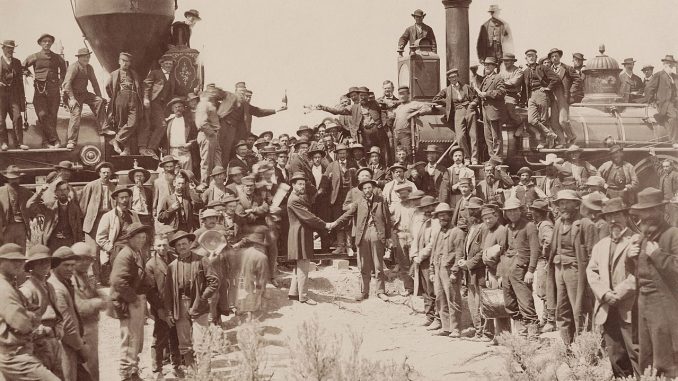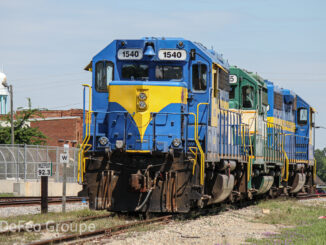
Completing the First Transcontinental Railroad was among the most significant accomplishments, if not the single greatest, in railroad history.
Workers completed the line on May 10, 1869.
“Next to winning the Civil War and abolishing slavery, building the first transcontinental railroad, from Omaha, Nebraska, to Sacramento, California, was the greatest achievement of the American people in the nineteenth century,” Stephen Ambrose said his book, “Nothing Like It In the World: The Men Who Built the Transcontinental Railroad 1863-1869.” “Not until the completion of the Panama Canal in the early twentieth century was it rivaled as an engineering feat.
“The railroad took brains, muscle, and sweat in quantities and scope never before put into a single project,” Ambrose added.
Proponents of a transcontinental railroad discussed the idea at least as early as the 1840s. In November 1845, The Cadiz Sentinel newspaper in Cadiz, Ohio, reported:
At the close of the last session, of Congress, Mr. Asa Whitney, a merchant from New York, presented a memorial soliciting from them a grant of the public lands for the purpose of constructing a Railroad from Lake Michigan to the Pacific. The project was a startling one, and so vast and apparently chimerical, that few seemed willing to grapple with it, or to entertain it as feasible. But the committee to whom the memorial was referred, and before whom Mr. Whitney appeared and unfolded his , views, were convinced of its practicability, and of the vasLiesulls which must follow from it to the country, and accordingly made a report in its favor; but the report came in at the end of the session, when the thoughts of all were engrossed with the then all absorbing topic of the annexation of Texas, and no further action was had upon the matter.
But it wasn’t until President Abraham Lincoln signed the Pacific Railroad Act of 1862 into law on July 1, 1862, that the idea picked up steam.
The law created a pair of companies to construct the railroad: the Central Pacific Railroad Company of California (CPRR) in the west and the Union Pacific Railroad in the Midwest.
The Central Pacific broke ground on its portion of the project on January 8, 1863, during the Civil War. The Union Pacific began construction in July 1865, shortly after the end of the war.
The railroads met at Promontory Summit. Photographer Andrew J. Russell captured the moment in one of the most famous photographs in history.
The two locomotives featured in the picture — Union Pacific No. 119 and Jupiter No. 60 — were scrapped during the early 20th century. Replicas are on display at the Golden Spike National Historical Park, which commemorates the completion of the First Transcontinental Railroad.
In the end, the Central Pacific built 690 miles eastward from Sacramento, while the Union Pacific built 1,085 miles westward from Omaha.
Interestingly, the transcontinental route did not last all that long. The railroad replaced the line, later known as the “Overland Route,” after opening the “Lucin Cutoff” from Ogden, Utah, to Lucin, Utah, in 1904. Rails at Promontory Summit were removed in 1942 and recycled for the World War II effort as part of a ceremonial “undriving” of the last spike ceremony.





